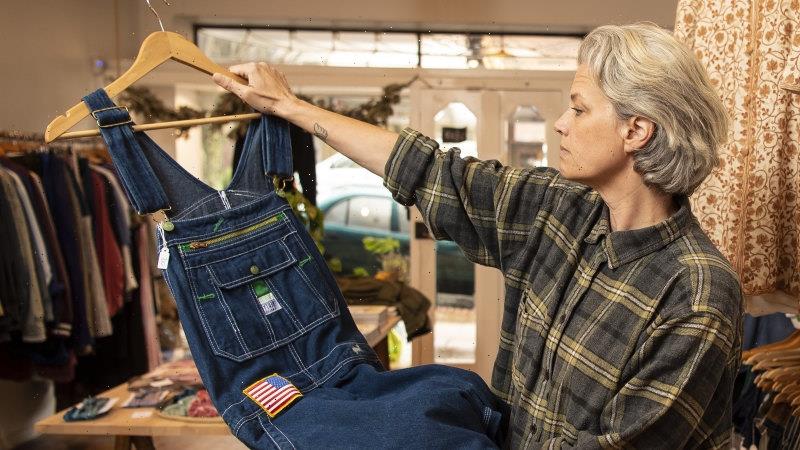When Allegra Benmayor was a teenager, she bought a vintage Yves Saint Laurent wallet for 50 cents and sold it online for $150. It began a passion for rummaging through old clothing and accessories, and she has since turned this hobby into a career.
For the past four-and-a-half years she has travelled to op shops all over NSW to source vintage wares for her store in Katoomba.
Shop assistant Amy Sather Smith checks the goods at Allegra Benmayor’s Old Flame Studio in Katoomba.Credit:Wolter Peeters
In the past year or two she has noticed a dramatic increase in fast fashion brands being discarded and appearing on the racks of second-hand stores – at a time when consumers are turning increasingly to ethical and environmentally conscious buying.
“I used to be able to walk out with 20 kilograms of clothes easily, good quality clothes, now I find it hard to even buy like 5kg. It’s like, 99 per cent of the clothes in there are fast fashion,” she said.
Brands that are frequently popping up include online fast fashion brands such as Shein, Boohoo, Big W and Kmart brand Anko, Benmayor said.
“People are just chucking out a white T-shirt that is stained like no one would re-buy that,” she said. “There’s a level of not being responsible, not even knowing or not even caring about how to dispose of your clothes if they are no longer wearable, just passing that responsibility on to someone else.”
Researcher from the Institute for Sustainable Futures at the University of Technology Sydney Dr Taylor Brydges said fast fashion is a general term for trendy, low-cost clothing that is mass-produced and disposable.
“Fast fashion itself was actually designed to be worn less than seven times,” Brydges said. “It has this short lifespan built into it.
“It encourages the obsolescence of those garments because it’s constantly creating consumer demand for those new items. So it’s been estimated that now we’re producing about a billion new items of clothing every year.”
With the average Australian buying 27 kilograms of new clothes and disposing of 23 kilograms each year, Australia is the second-highest consumer of textiles per person worldwide, behind the United States, the Australian Department of Agriculture, Water and Environment has reported.
“It’s not only the environmental impact, like who’s paying the cost of us having this cheaper clothing,” Brydges said. “It’s also social sustainability as well because we know that garment production has been outsourced to low-cost, low-wage producers with probably women doing this kind of work.”
To keep garment prices low, fast fashion production is often outsourced to factories overseas, where there is little oversight of the workplace conditions.
“When you get into it, the local charity shops have really become a key actor in terms of trying to divert some of that waste from landfill, but they can only do so much,” Brydges said.
A study from Charitable Recycling Australia said that 16.5 per cent of textiles donated to charity stores are resold.
Thrift shopping has become more fashionable in recent years, particularly among younger consumers. In 2019, about 40 per cent of Generation Z (those born between 1997 and 2012) said that they were buying outfits second hand, reselling site ThredUp said.
Meanwhile, nine in 10 Gen Z consumers believe “companies have a responsibility to address environmental and social issues”, a 2019 report from McKinsey found.
The growing concern about sustainable shopping has yet to slow the number of fast fashion donations hauled into op-shops, which are left with the task to keep the clothing out of landfill.
“[Fast fashion donations] are all occurring in increasing amounts, I’ve definitely noticed in the last couple of months,” said customer experience representative for the Salvation Army, Aife O’Loughlin.
“The way that fast fashion is manufactured means it’s probably not as durable. It’s complicated but it’s being produced and being sold so the more we keep out of landfill the better.
“There’s always going to be a consumer of fast fashion at this stage. Our goal is to keep items in use as much as possible.”
Make the most of your health, relationships, fitness and nutrition with our Live Well newsletter. Get it in your inbox every Monday.
Most Viewed in Lifestyle
From our partners
Source: Read Full Article

